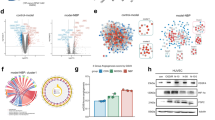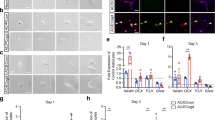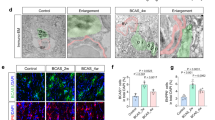Abstract
Uncontrolled expression of vascular endothelial growth factor (VEGF) in vivo may cause unexpected side effects, such as brain hemangioma or tumor growth. Because hypoxia-inducible factor-1 (HIF-1) is upregulated during cerebral ischemia and regulates gene expression by binding to a cis-acting hypoxia-responsive element (HRE), we therefore used a novel HRE, originating in the 3′-end of the erythropoietin (Epo) gene, to control gene expression in the ischemic brain. A concatemer of nine copies (H9) of the consensus sequence of HRE was used to mediate hypoxia induction. Three groups of adult CD-1 mice received AAVH9-VEGF, AAVH9-lacZ or saline injection, and then underwent 45 min of transient middle cerebral artery occlusion (tMCAO). Results show that HIF-1 was persistently expressed in the ischemic brain. VEGF was overexpressed in the ischemic perifocal region in AAVH9-VEGF-transduced mice. Double-labeled immunostaining showed that VEGF expressed in neurons and astrocytes but not endothelial cells, suggesting that adeno-associated virus (AAV) vectors transduced neurons and astrocytes predominantly. The total number of microvessels/enlarged microvessels was greatly increased in the AAVH9-VEGF-transduced mice (180±29/27±4) compared to the AAVH9-lacZ (118±19/14±3) or saline-treated (119±20/14±2) mice after tMCAO (P<0.05). Cell proliferation examination demonstrated that these microvessels were newly formed. Regional cerebral blood flow recovery in the AAVH9-VEGF-transduced mice was also better than in AAVH9-lacZ or saline-treated mice (P<0.05). Our data indicated that HRE is a novel trigger for the control of VEGF expression in the ischemic brain. VEGF overexpression through AAVH9-VEGF gene transfer showed stable focal angiogenic effects in post-ischemic repair process, providing an opportunity to rebuild injured brain tissue.
This is a preview of subscription content, access via your institution
Access options
Subscribe to this journal
Receive 12 print issues and online access
$259.00 per year
only $21.58 per issue
Buy this article
- Purchase on Springer Link
- Instant access to full article PDF
Prices may be subject to local taxes which are calculated during checkout







Similar content being viewed by others
Abbreviations
- AAV:
-
adeno-associated viral vector
- AAV-VEGF:
-
AAV encoding VEGF165 gene
- AAV-lacZ:
-
AAV encoding β-galactosidase gene
- PCNA:
-
proliferating cell nuclear antigen
- VEGF:
-
vascular endothelial growth factor
References
Krupinski J, Kaluza J, Kumar P, Wang M, Kumar S . Prognostic value of blood vessel density in ischaemic stroke. Lancet 1993; 342: 742.
Cramer SC, Nelles G, Benson RR, Kaplan JD, Parker RA, Kwong KK et al. A functional MRI study of subjects recovered from hemiparetic stroke. Stroke 1997; 28: 2518–2527.
Slevin M, Krupinski J, Slowik A, Kumar P, Szczudlik A, Gaffney J . Serial measurement of vascular endothelial growth factor and transforming growth factor-beta1 in serum of patients with acute ischemic stroke. Stroke 2000; 31: 1863–1870.
Wang Y, Kilic E, Kilic U, Weber B, Bassetti CL, Marti HH et al. VEGF overexpression induces post-ischaemic neuroprotection, but facilitates haemodynamic steal phenomena. Brain 2005; 128: 52–63.
Sun Y, Jin K, Xie L, Childs J, Mao XO, Logvinova A et al. VEGF-induced neuroprotection, neurogenesis, and angiogenesis after focal cerebral ischemia. J Clin Invest 2003; 111: 1843–1851.
Zhang R, Wang L, Zhang L, Chen J, Zhu Z, Zhang Z et al. Nitric oxide enhances angiogenesis via the synthesis of vascular endothelial growth factor and cGMP after stroke in the rat. Circ Res 2003; 92: 308–313.
Conway EM, Collen D, Carmeliet P . Molecular mechanisms of blood vessel growth. Cardiovasc Res 2001; 49: 507–521.
Hills CP . Ultrastructural changes in the capillary bed of the rat cerebral cortex in anoxic–ischemic brain lesions. Am J Pathol 1964; 44: 531–551.
Coyle P . Diameter and length changes in cerebral collaterals after middle cerebral artery occlusion in the young rat. Anat Rec 1984; 210: 357–364.
Coyle P, Heistad DD . Blood flow through cerebral collateral vessels one month after middle cerebral artery occlusion. Stroke 1987; 18: 407–411.
Garcia JH, Liu KF, Yoshida Y, Lian J, Chen S, del Zoppo GJ . Influx of leukocytes and platelets in an evolving brain infarct (Wistar rat). Am J Pathol 1994; 144: 188–199.
Sbarbati A, Pietra C, Baldassarri AM, Guerrini U, Ziviani L, Reggiani A et al. The microvascular system in ischemic cortical lesions. Acta Neuropathol (Berl) 1996; 92: 56–63.
Yancopoulos GD, Davis S, Gale NW, Rudge JS, Wiegand SJ, Holash J . Vascular-specific growth factors and blood vessel formation. Nature 2000; 407: 242–248.
Rosenstein JM, Mani N, Silverman WF, Krum JM . Patterns of brain angiogenesis after vascular endothelial growth factor administration in vitro and in vivo. Proc Natl Acad Sci USA 1998; 95: 7086–7091.
Monahan PE, Samulski RJ . Adeno-associated virus vectors for gene therapy: more pros than cons? Mol Med Today 2000; 6: 433–440.
Zaiss AK, Liu Q, Bowen GP, Wong NC, Bartlett JS, Muruve DA . Differential activation of innate immune responses by adenovirus and adeno-associated virus vectors. J Virol 2002; 76: 4580–4590.
Lee RJ, Springer ML, Blanco-Bose WE, Shaw R, Ursell PC, Blau HM . VEGF gene delivery to myocardium: deleterious effects of unregulated expression. Circulation 2000; 102: 898–901.
Springer ML, Chen AS, Kraft PE, Bednarski M, Blau HM . VEGF gene delivery to muscle: potential role for vasculogenesis in adults. Mol Cell 1998; 2: 549–558.
Bohl D, Salvetti A, Moullier P, Heard JM . Control of erythropoietin delivery by doxycycline in mice after intramuscular injection of adeno-associated vector. Blood 1998; 92: 1512–1517.
Hofmann A, Nolan GP, Blau HM . Rapid retroviral delivery of tetracycline-inducible genes in a single autoregulatory cassette. Proc Natl Acad Sci USA 1996; 93: 5185–5190.
Bohl D, Naffakh N, Heard JM . Long-term control of erythropoietin secretion by doxycycline in mice transplanted with engineered primary myoblasts. Nat Med 1997; 3: 299–305.
Gossen M, Bujard H . Tight control of gene expression in mammalian cells by tetracycline-responsive promoters. Proc Natl Acad Sci USA 1992; 89: 5547–5551.
Blau HM, Rossi FM . Tet B or not tet B: advances in tetracycline-inducible gene expression. Proc Natl Acad Sci USA 1999; 96: 797–799.
Rossi FM, Guicherit OM, Spicher A, Kringstein AM, Fatyol K, Blakely BT et al. Tetracycline-regulatable factors with distinct dimerization domains allow reversible growth inhibition by p16. Nat Genet 1998; 20: 389–393.
Kringstein AM, Rossi FM, Hofmann A, Blau HM . Graded transcriptional response to different concentrations of a single transactivator. Proc Natl Acad Sci USA 1998; 95: 13670–13675.
Wang GL, Jiang BH, Rue EA, Semenza GL . Hypoxia-inducible factor 1 is a basic–helix–loop–helix–PAS heterodimer regulated by cellular O2 tension. Proc Natl Acad Sci USA 1995; 92: 5510–5514.
Post DE, Van Meir EG . Generation of bidirectional hypoxia/HIF-responsive expression vectors to target gene expression to hypoxic cells. Gene Therapy 2001; 8: 1801–1807.
Su H, Arakawa-Hoyt J, Kan YW . Adeno-associated viral vector-mediated hypoxia response element-regulated gene expression in mouse ischemic heart model. Proc Natl Acad Sci USA 2002; 99: 9480–9485.
Betz AL, Yang GY, Davidson BL . Attenuation of stroke size in rats using an adenoviral vector to induce overexpression of interleukin-1 receptor antagonist in brain. J Cereb Blood Flow Metab 1995; 15: 547–551.
Parenti A, Bellik L, Brogelli L, Filippi S, Ledda F . Endogenous VEGF-A is responsible for mitogenic effects of MCP-1 on vascular smooth muscle cells. Am J Physiol Heart Circ Physiol 2004; 286: H1978–H1984.
Laguens R, Cabeza Meckert P, Vera Janavel G, Del Valle H, Lascano E, Negroni J et al. Entrance in mitosis of adult cardiomyocytes in ischemic pig hearts after plasmid-mediated rhVEGF165 gene transfer. Gene Therapy 2002; 9: 1676–1681.
Leker RR, Teichner A, Ovadia H, Keshet E, Reinherz E, Ben-Hur T . Expression of endothelial nitric oxide synthase in the ischemic penumbra: relationship to expression of neuronal nitric oxide synthase and vascular endothelial growth factor. Brain Res 2001; 909: 1–7.
Carmeliet P . Mechanisms of angiogenesis and arteriogenesis. Nat Med 2000; 6: 389–395.
Pettersson A, Nagy JA, Brown LF, Sundberg C, Morgan E, Jungles S et al. Heterogeneity of the angiogenic response induced in different normal adult tissues by vascular permeability factor/vascular endothelial growth factor. Lab Invest 2000; 80: 99–115.
Cobbs CS, Chen J, Greenberg DA, Graham SH . Vascular endothelial growth factor expression in transient focal cerebral ischemia in the rat. Neurosci Lett 1998; 249: 79–82.
Hayashi T, Abe K, Suzuki H, Itoyama Y . Rapid induction of vascular endothelial growth factor gene expression after transient middle cerebral artery occlusion in rats. Stroke 1997; 28: 2039–2044.
Kovacs Z, Ikezaki K, Samoto K, Inamura T, Fukui M . VEGF and flt. Expression time kinetics in rat brain infarct. Stroke 1996; 27: 1865–1872; discussion 1872–1863.
Lennmyr F, Ata KA, Funa K, Olsson Y, Terent A . Expression of vascular endothelial growth factor (VEGF) and its receptors (Flt-1 and Flk-1) following permanent and transient occlusion of the middle cerebral artery in the rat. J Neuropathol Exp Neurol 1998; 57: 874–882.
Plate KH, Beck H, Danner S, Allegrini PR, Wiessner C . Cell type specific upregulation of vascular endothelial growth factor in an MCA-occlusion model of cerebral infarct. J Neuropathol Exp Neurol 1999; 58: 654–666.
Jin KL, Mao XO, Greenberg DA . Vascular endothelial growth factor: direct neuroprotective effect in in vitro ischemia. Proc Natl Acad Sci USA 2000; 97: 10242–10247.
Issa R, Krupinski J, Bujny T, Kumar S, Kaluza J, Kumar P . Vascular endothelial growth factor and its receptor, KDR, in human brain tissue after ischemic stroke. Lab Invest 1999; 79: 417–425.
Lee OH, Kim YM, Lee YM, Moon EJ, Lee DJ, Kim JH et al. Sphingosine 1-phosphate induces angiogenesis: its angiogenic action and signaling mechanism in human umbilical vein endothelial cells. Biochem Biophys Res Commun 1999; 264: 743–750.
Tenenbaum L, Chtarto A, Lehtonen E, Velu T, Brotchi J, Levivier M . Recombinant AAV-mediated gene delivery to the central nervous system. J Gene Med 2004; 6 (Suppl 1): S212–S222.
Burger C, Gorbatyuk OS, Velardo MJ, Peden CS, Williams P, Zolotukhin S et al. Recombinant AAV viral vectors pseudotyped with viral capsids from serotypes 1, 2, and 5 display differential efficiency and cell tropism after delivery to different regions of the central nervous system. Mol Ther 2004; 10: 302–317.
Garcia JH, Kalimo H, Kamijyo Y, Trump BF . Cellular events during partial cerebral ischemia. I. Electron microscopy of feline cerebral cortex after middle-cerebral-artery occlusion. Virchows Arch B Cell Pathol 1977; 25: 191–206.
Zhang ZG, Zhang L, Jiang Q, Zhang R, Davies K, Powers C et al. VEGF enhances angiogenesis and promotes blood–brain barrier leakage in the ischemic brain. J Clin Invest 2000; 106: 829–838.
Schielke GP, Yang GY, Shivers BD, Betz AL . Reduced ischemic brain injury in interleukin-1 beta converting enzyme-deficient mice. J Cereb Blood Flow Metab 1998; 18: 180–185.
Ayata C, Dunn AK, Gursoy OY, Huang Z, Boas DA, Moskowitz MA . Laser speckle flowmetry for the study of cerebrovascular physiology in normal and ischemic mouse cortex. J Cereb Blood Flow Metab 2004; 24: 744–755.
Gruber M, Hu CJ, Johnson RS, Brown EJ, Keith B, Simon MC . Acute postnatal ablation of Hif-2alpha results in anemia. Proc Natl Acad Sci USA 2007; 104: 2301–2306.
Zhu Y, Lawton MT, Du R, Shwe Y, Chen Y, Shen F et al. Expression of hypoxia-inducible factor-1 and vascular endothelial growth factor in response to venous hypertension. Neurosurgery 2006; 59: 687–696; discussion 687–696.
Kim CH, Cho YS, Chun YS, Park JW, Kim MS . Early expression of myocardial HIF-1alpha in response to mechanical stresses: regulation by stretch-activated channels and the phosphatidylinositol 3-kinase signaling pathway. Circ Res 2002; 90: E25–E33.
Pufe T, Lemke A, Kurz B, Petersen W, Tillmann B, Grodzinsky AJ et al. Mechanical overload induces VEGF in cartilage discs via hypoxia-inducible factor. Am J Pathol 2004; 164: 185–192.
Su H, Lu R, Kan YW . Adeno-associated viral vector-mediated vascular endothelial growth factor gene transfer induces neovascular formation in ischemic heart. Proc Natl Acad Sci USA 2000; 97: 13801–13806.
Yang GY, Zhao Y, Davidson BL, Betz AL . Overexpression of interleukin-1 receptor antagonist in the mouse brain reduces ischemic brain injury. Brain Res 1997; 751: 181–188.
Pang L, Ye W, Che XM, Roessler BJ, Betz AL, Yang GY . Reduction of inflammatory response in the mouse brain with adenoviral- mediated transforming growth factor-ss1 expression. Stroke 2001; 32: 544–552.
Yang GY, Chan PH, Chen J, Carlson E, Chen SF, Weinstein P et al. Human copper-zinc superoxide dismutase transgenic mice are highly resistant to reperfusion injury after focal cerebral ischemia. Stroke 1994; 25: 165–170.
Acknowledgements
These studies were supported by NIH Grants: R01 NS027713 (WLY), R21 NS050668 (GYY) and P01 NS044145 (WLY, GYY). We thank Voltaire Gungab for editorial assistance, and the staff of the Center for Cerebrovascular Research (http://avm.ucsf.edu/) for their collaborative support.
Author information
Authors and Affiliations
Corresponding author
Rights and permissions
About this article
Cite this article
Shen, F., Fan, Y., Su, H. et al. Adeno-associated viral vector-mediated hypoxia-regulated VEGF gene transfer promotes angiogenesis following focal cerebral ischemia in mice. Gene Ther 15, 30–39 (2008). https://doi.org/10.1038/sj.gt.3303048
Received:
Revised:
Accepted:
Published:
Issue Date:
DOI: https://doi.org/10.1038/sj.gt.3303048
Keywords
This article is cited by
-
Nucleic acid drug vectors for diagnosis and treatment of brain diseases
Signal Transduction and Targeted Therapy (2023)
-
The role of non-coding RNAs in neuroprotection and angiogenesis following ischemic stroke
Metabolic Brain Disease (2020)
-
Destination Brain: the Past, Present, and Future of Therapeutic Gene Delivery
Journal of Neuroimmune Pharmacology (2017)
-
MicroRNA-210 overexpression induces angiogenesis and neurogenesis in the normal adult mouse brain
Gene Therapy (2014)
-
Netrin-1 Overexpression Promotes White Matter Repairing and Remodeling after Focal Cerebral Ischemia in Mice
Journal of Cerebral Blood Flow & Metabolism (2013)



